Management Information Systems - Desklib
VerifiedAdded on 2023/06/10
|5
|1034
|429
AI Summary
This article discusses Management Information Systems and includes a multiple choice quiz, explanations of predictive analytics, DBMS, fuzzy logic, and the relationship between social media and web 2.0. It also explores the importance of people and information technology in organizations.
Contribute Materials
Your contribution can guide someone’s learning journey. Share your
documents today.
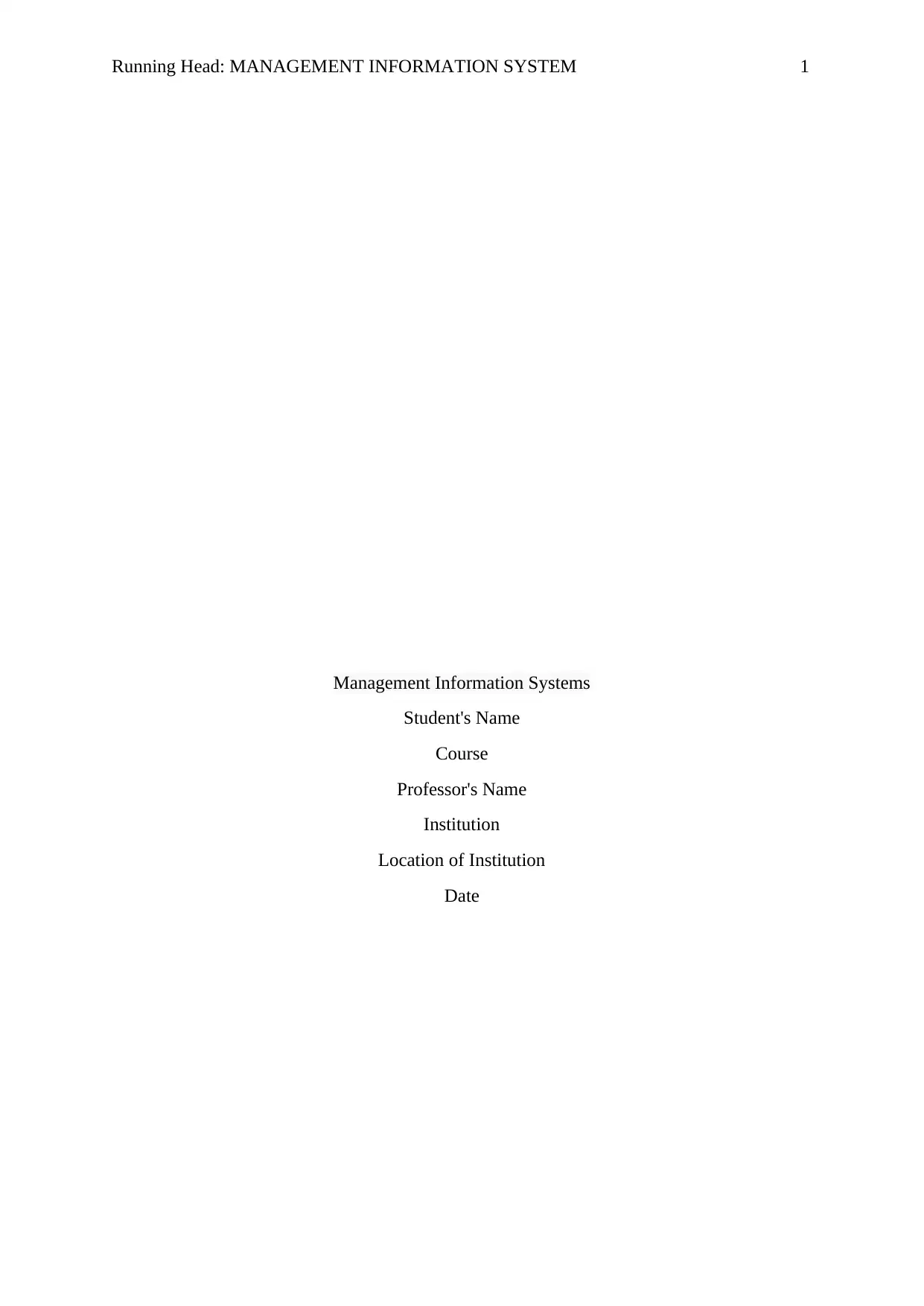
Running Head: MANAGEMENT INFORMATION SYSTEM 1
Management Information Systems
Student's Name
Course
Professor's Name
Institution
Location of Institution
Date
Management Information Systems
Student's Name
Course
Professor's Name
Institution
Location of Institution
Date
Secure Best Marks with AI Grader
Need help grading? Try our AI Grader for instant feedback on your assignments.
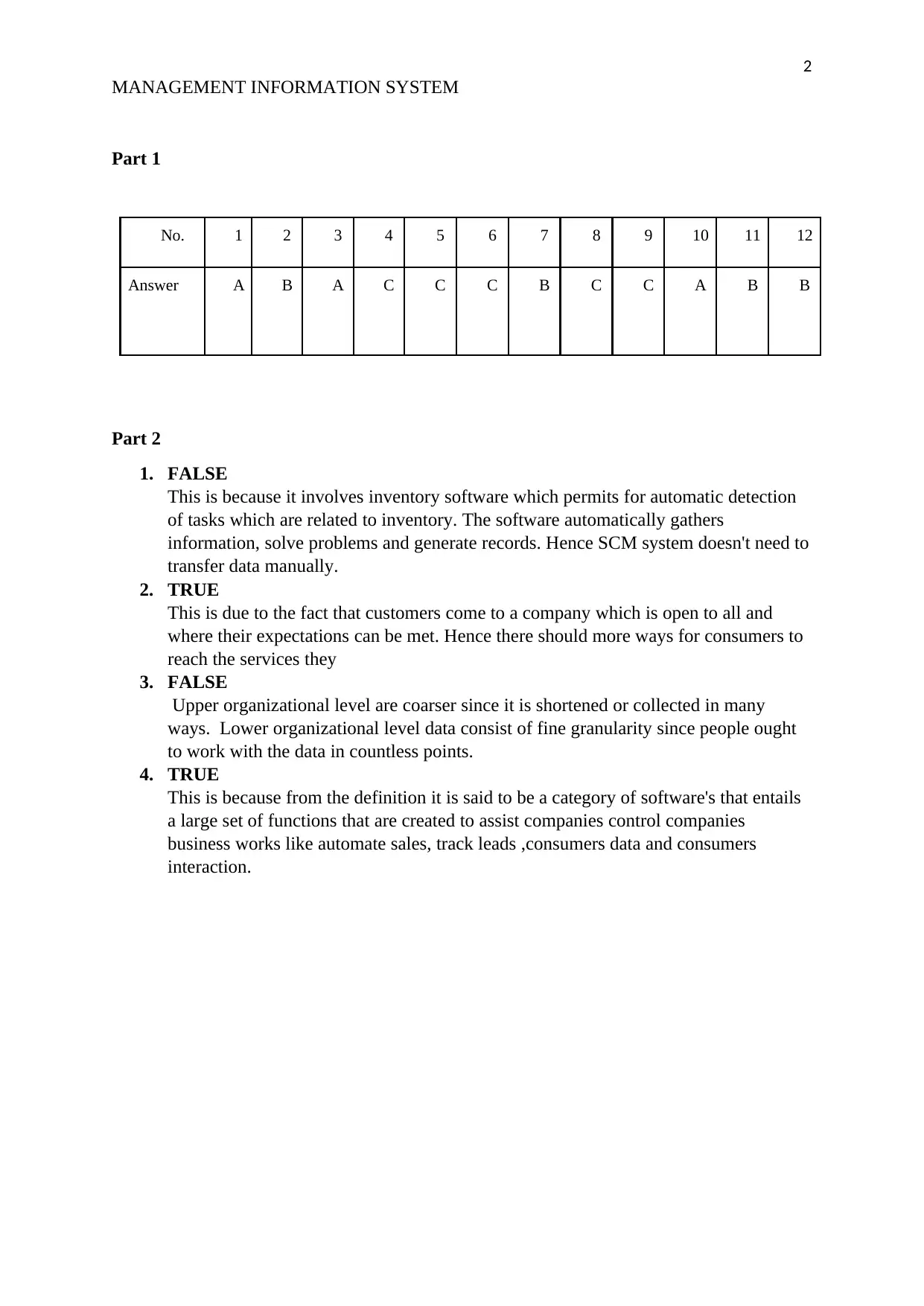
2
MANAGEMENT INFORMATION SYSTEM
Part 1
No. 1 2 3 4 5 6 7 8 9 10 11 12
Answer A B A C C C B C C A B B
Part 2
1. FALSE
This is because it involves inventory software which permits for automatic detection
of tasks which are related to inventory. The software automatically gathers
information, solve problems and generate records. Hence SCM system doesn't need to
transfer data manually.
2. TRUE
This is due to the fact that customers come to a company which is open to all and
where their expectations can be met. Hence there should more ways for consumers to
reach the services they
3. FALSE
Upper organizational level are coarser since it is shortened or collected in many
ways. Lower organizational level data consist of fine granularity since people ought
to work with the data in countless points.
4. TRUE
This is because from the definition it is said to be a category of software's that entails
a large set of functions that are created to assist companies control companies
business works like automate sales, track leads ,consumers data and consumers
interaction.
MANAGEMENT INFORMATION SYSTEM
Part 1
No. 1 2 3 4 5 6 7 8 9 10 11 12
Answer A B A C C C B C C A B B
Part 2
1. FALSE
This is because it involves inventory software which permits for automatic detection
of tasks which are related to inventory. The software automatically gathers
information, solve problems and generate records. Hence SCM system doesn't need to
transfer data manually.
2. TRUE
This is due to the fact that customers come to a company which is open to all and
where their expectations can be met. Hence there should more ways for consumers to
reach the services they
3. FALSE
Upper organizational level are coarser since it is shortened or collected in many
ways. Lower organizational level data consist of fine granularity since people ought
to work with the data in countless points.
4. TRUE
This is because from the definition it is said to be a category of software's that entails
a large set of functions that are created to assist companies control companies
business works like automate sales, track leads ,consumers data and consumers
interaction.
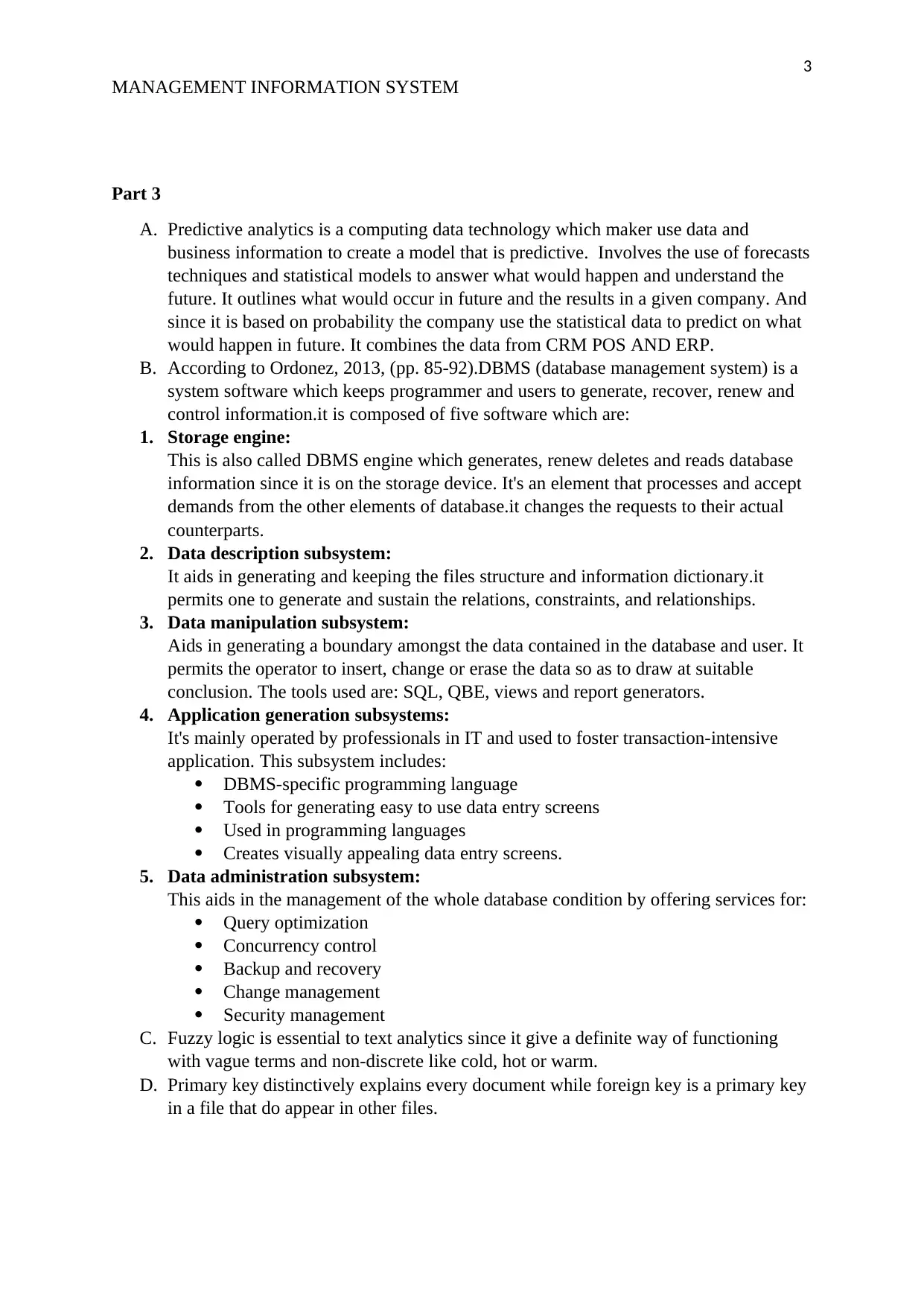
3
MANAGEMENT INFORMATION SYSTEM
Part 3
A. Predictive analytics is a computing data technology which maker use data and
business information to create a model that is predictive. Involves the use of forecasts
techniques and statistical models to answer what would happen and understand the
future. It outlines what would occur in future and the results in a given company. And
since it is based on probability the company use the statistical data to predict on what
would happen in future. It combines the data from CRM POS AND ERP.
B. According to Ordonez, 2013, (pp. 85-92).DBMS (database management system) is a
system software which keeps programmer and users to generate, recover, renew and
control information.it is composed of five software which are:
1. Storage engine:
This is also called DBMS engine which generates, renew deletes and reads database
information since it is on the storage device. It's an element that processes and accept
demands from the other elements of database.it changes the requests to their actual
counterparts.
2. Data description subsystem:
It aids in generating and keeping the files structure and information dictionary.it
permits one to generate and sustain the relations, constraints, and relationships.
3. Data manipulation subsystem:
Aids in generating a boundary amongst the data contained in the database and user. It
permits the operator to insert, change or erase the data so as to draw at suitable
conclusion. The tools used are: SQL, QBE, views and report generators.
4. Application generation subsystems:
It's mainly operated by professionals in IT and used to foster transaction-intensive
application. This subsystem includes:
DBMS-specific programming language
Tools for generating easy to use data entry screens
Used in programming languages
Creates visually appealing data entry screens.
5. Data administration subsystem:
This aids in the management of the whole database condition by offering services for:
Query optimization
Concurrency control
Backup and recovery
Change management
Security management
C. Fuzzy logic is essential to text analytics since it give a definite way of functioning
with vague terms and non-discrete like cold, hot or warm.
D. Primary key distinctively explains every document while foreign key is a primary key
in a file that do appear in other files.
MANAGEMENT INFORMATION SYSTEM
Part 3
A. Predictive analytics is a computing data technology which maker use data and
business information to create a model that is predictive. Involves the use of forecasts
techniques and statistical models to answer what would happen and understand the
future. It outlines what would occur in future and the results in a given company. And
since it is based on probability the company use the statistical data to predict on what
would happen in future. It combines the data from CRM POS AND ERP.
B. According to Ordonez, 2013, (pp. 85-92).DBMS (database management system) is a
system software which keeps programmer and users to generate, recover, renew and
control information.it is composed of five software which are:
1. Storage engine:
This is also called DBMS engine which generates, renew deletes and reads database
information since it is on the storage device. It's an element that processes and accept
demands from the other elements of database.it changes the requests to their actual
counterparts.
2. Data description subsystem:
It aids in generating and keeping the files structure and information dictionary.it
permits one to generate and sustain the relations, constraints, and relationships.
3. Data manipulation subsystem:
Aids in generating a boundary amongst the data contained in the database and user. It
permits the operator to insert, change or erase the data so as to draw at suitable
conclusion. The tools used are: SQL, QBE, views and report generators.
4. Application generation subsystems:
It's mainly operated by professionals in IT and used to foster transaction-intensive
application. This subsystem includes:
DBMS-specific programming language
Tools for generating easy to use data entry screens
Used in programming languages
Creates visually appealing data entry screens.
5. Data administration subsystem:
This aids in the management of the whole database condition by offering services for:
Query optimization
Concurrency control
Backup and recovery
Change management
Security management
C. Fuzzy logic is essential to text analytics since it give a definite way of functioning
with vague terms and non-discrete like cold, hot or warm.
D. Primary key distinctively explains every document while foreign key is a primary key
in a file that do appear in other files.
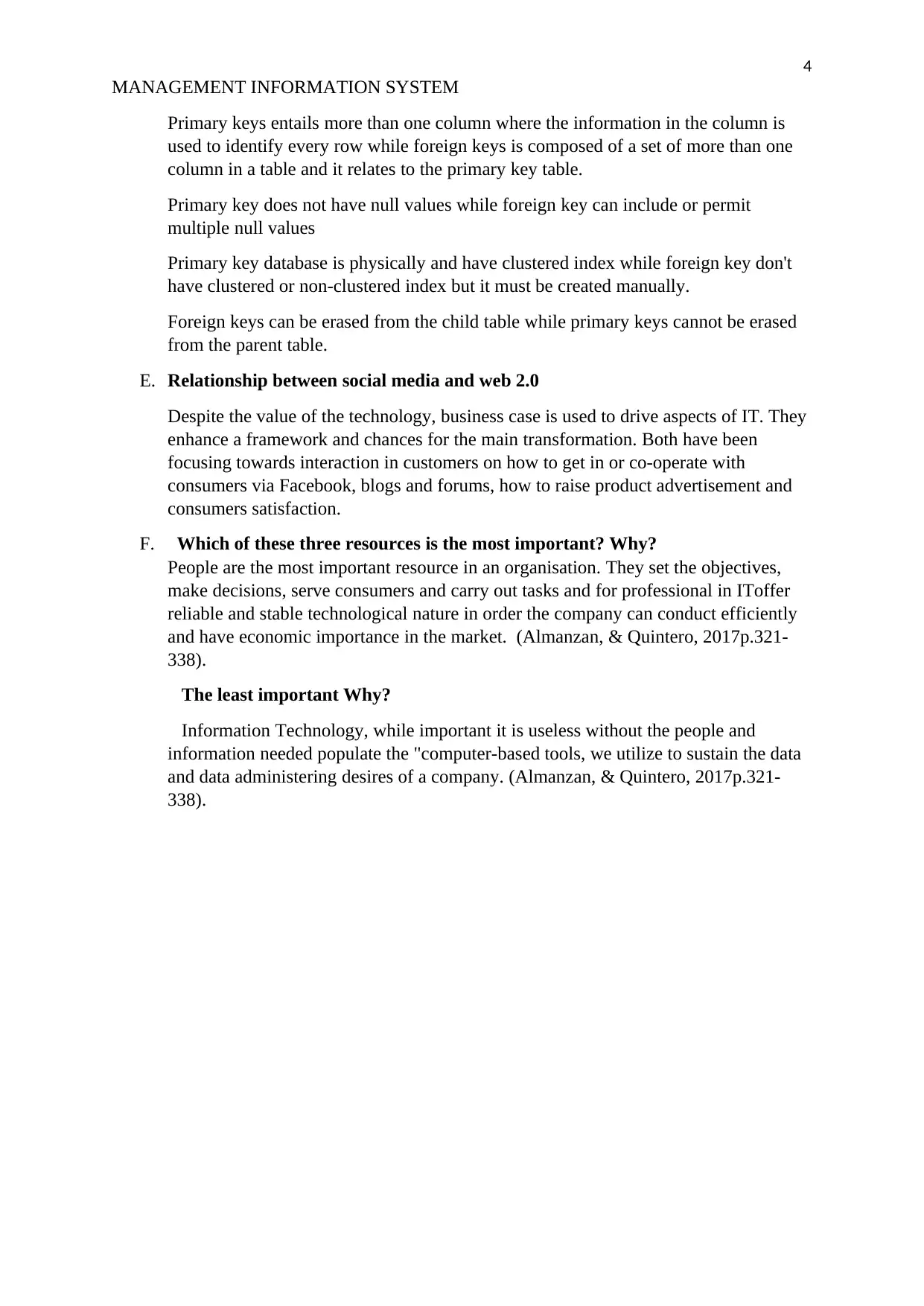
4
MANAGEMENT INFORMATION SYSTEM
Primary keys entails more than one column where the information in the column is
used to identify every row while foreign keys is composed of a set of more than one
column in a table and it relates to the primary key table.
Primary key does not have null values while foreign key can include or permit
multiple null values
Primary key database is physically and have clustered index while foreign key don't
have clustered or non-clustered index but it must be created manually.
Foreign keys can be erased from the child table while primary keys cannot be erased
from the parent table.
E. Relationship between social media and web 2.0
Despite the value of the technology, business case is used to drive aspects of IT. They
enhance a framework and chances for the main transformation. Both have been
focusing towards interaction in customers on how to get in or co-operate with
consumers via Facebook, blogs and forums, how to raise product advertisement and
consumers satisfaction.
F. Which of these three resources is the most important? Why?
People are the most important resource in an organisation. They set the objectives,
make decisions, serve consumers and carry out tasks and for professional in IToffer
reliable and stable technological nature in order the company can conduct efficiently
and have economic importance in the market. (Almanzan, & Quintero, 2017p.321-
338).
The least important Why?
Information Technology, while important it is useless without the people and
information needed populate the "computer-based tools, we utilize to sustain the data
and data administering desires of a company. (Almanzan, & Quintero, 2017p.321-
338).
MANAGEMENT INFORMATION SYSTEM
Primary keys entails more than one column where the information in the column is
used to identify every row while foreign keys is composed of a set of more than one
column in a table and it relates to the primary key table.
Primary key does not have null values while foreign key can include or permit
multiple null values
Primary key database is physically and have clustered index while foreign key don't
have clustered or non-clustered index but it must be created manually.
Foreign keys can be erased from the child table while primary keys cannot be erased
from the parent table.
E. Relationship between social media and web 2.0
Despite the value of the technology, business case is used to drive aspects of IT. They
enhance a framework and chances for the main transformation. Both have been
focusing towards interaction in customers on how to get in or co-operate with
consumers via Facebook, blogs and forums, how to raise product advertisement and
consumers satisfaction.
F. Which of these three resources is the most important? Why?
People are the most important resource in an organisation. They set the objectives,
make decisions, serve consumers and carry out tasks and for professional in IToffer
reliable and stable technological nature in order the company can conduct efficiently
and have economic importance in the market. (Almanzan, & Quintero, 2017p.321-
338).
The least important Why?
Information Technology, while important it is useless without the people and
information needed populate the "computer-based tools, we utilize to sustain the data
and data administering desires of a company. (Almanzan, & Quintero, 2017p.321-
338).
Secure Best Marks with AI Grader
Need help grading? Try our AI Grader for instant feedback on your assignments.
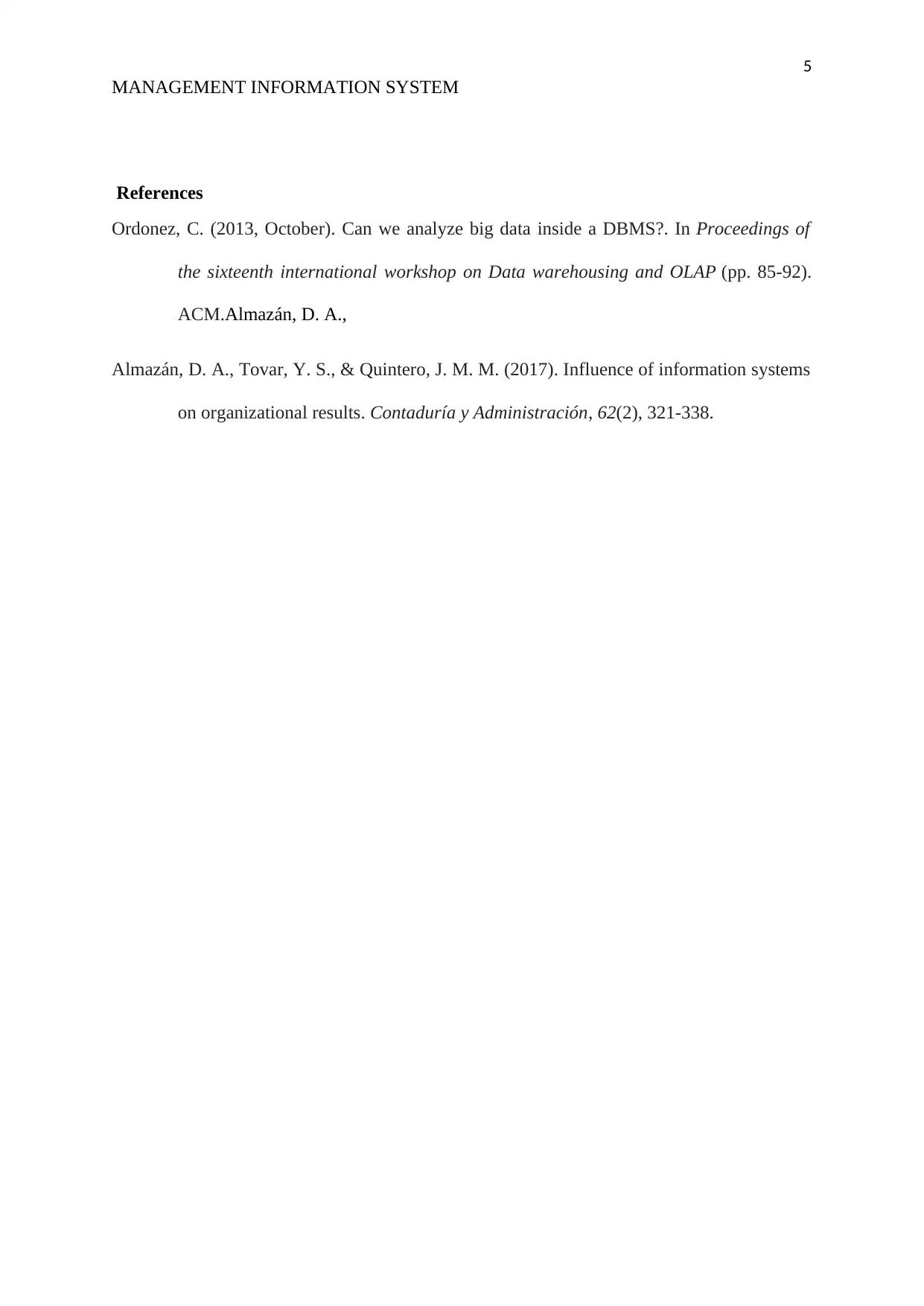
5
MANAGEMENT INFORMATION SYSTEM
References
Ordonez, C. (2013, October). Can we analyze big data inside a DBMS?. In Proceedings of
the sixteenth international workshop on Data warehousing and OLAP (pp. 85-92).
ACM.Almazán, D. A.,
Almazán, D. A., Tovar, Y. S., & Quintero, J. M. M. (2017). Influence of information systems
on organizational results. Contaduría y Administración, 62(2), 321-338.
MANAGEMENT INFORMATION SYSTEM
References
Ordonez, C. (2013, October). Can we analyze big data inside a DBMS?. In Proceedings of
the sixteenth international workshop on Data warehousing and OLAP (pp. 85-92).
ACM.Almazán, D. A.,
Almazán, D. A., Tovar, Y. S., & Quintero, J. M. M. (2017). Influence of information systems
on organizational results. Contaduría y Administración, 62(2), 321-338.
1 out of 5
Related Documents
Your All-in-One AI-Powered Toolkit for Academic Success.
+13062052269
info@desklib.com
Available 24*7 on WhatsApp / Email
![[object Object]](/_next/static/media/star-bottom.7253800d.svg)
Unlock your academic potential
© 2024 | Zucol Services PVT LTD | All rights reserved.





